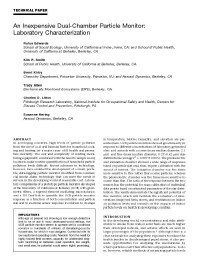Mining Publication: An Inexpensive Dual-Chamber Particle Monitor: Laboratory Characterization
Original creation date: June 2006
Authors: R Edwards, KR Smith, T Allen, CD Litton, S Hering
NIOSHTIC2 Number: 20030445
J Air Waste Manag Assoc 2006 Jun 56(6):789-799
In developing countries, high levels of particle pollution from the use of coal and biomass fuels for household cooking and heating are a major cause of ill health and premature mortality. The cost and complexity of existing monitoring equipment, combined with the need to sample many locations, make routine quantification of household particle pollution levels difficult. Recent advances in technology, however, have enabled the development of a small, portable, data-logging particle monitor modified from commercial smoke alarm technology that can meet the needs of surveys in the developing world at reasonable cost. Laboratory comparisons of a prototype particle monitor developed at the University of California at Berkeley (UCB) with gravimetric filters, a tapered element oscillating microbalance, and a TSI DustTrak to quantify the UCB particle monitor response as a function of both concentration and particle size and to examine sensor response in relation to changes in temperature, relative humidity, and elevation are presented here. UCB particle monitors showed good linearity in response to different concentrations of laboratory-generated oleic acid aerosols with a coarse (mass median diameter, 2.1 microm) and fine (mass median diameter, 0.27-0.42 microm) size distributions (average r2 = 0.997 +/- 0.005). The photoelectric and ionization chamber showed a wide range of responses based on particle size and, thus, require calibration with the aerosol of interest. The ionization chamber was five times more sensitive to fine rather than coarse particles, whereas the photoelectric chamber was five times more sensitive to coarse than fine. The ratio of the response between the two sensors has the potential for mass calibration of individual data points based on estimated parameters of the size distribution. The results demonstrate the significant potential of this monitor, which will facilitate the evaluation of interventions (improved fuels, stoves, and ventilation) on indoor air pollution levels and research on the impacts of indoor particle levels on health in developing countries.

NIOSHTIC2 Number: 20030445
J Air Waste Manag Assoc 2006 Jun 56(6):789-799
- Advances in Remote Sensing Techniques for Monitoring Rock Falls and Slope Failures
- Applications of Ground-Based Radar to Mine Slope Monitoring
- Monitoring and Removal of CO in Blasting Operations
- Performance Comparison of Rescue Breathing Apparatus
- Remote Monitoring of Mine Seismicity and Earthquakes Using Radio Telemetry, Computers, and the Internet
- Safer Mine Hoisting With Conveyance Position and Load Monitoring
- Stress Measurements for Safety Decisions in Longwall Coal
- Underground Mine Communications, Control and Monitoring
- Water and Slurry Bulkheads in Underground Coal Mines: Design, Monitoring, and Safety Concerns
- Work Practices to Manage Bump Prone Ground